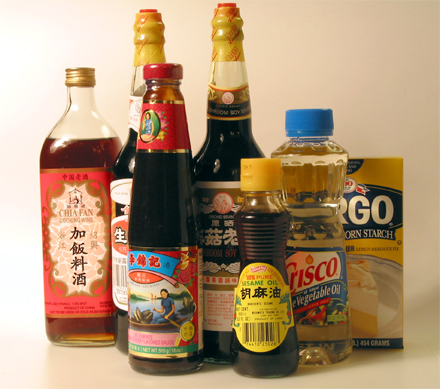
Oil and sauces clockwise from top left: oyster sauce, corn oil, dark soy sauce, light soy sauce and sesame oil
A few of my friends from downtown visited me in my kitchen on a Saturday night a few weeks ago. It was a rather unusual gathering. I was sharing with them some basic Chinese cooking techniques by way of demonstration. More often then not I would simply be cooking to entertain these friends. But on this occasion I had specifically been requested to show them stir-frying technique before we sat down to dinner. As I collected the ingredients and was explaining the different sauces and cooking wine, my neighbor Kim dropped in unannounced to borrow some fresh cilantro for her guacamole. (She is now officially a family member!) In her normal inquisitive manner she proceeded to ask me if there was a basic set of Chinese sauces and ingredients one should assemble as a “starter kit” for Chinese cooking?
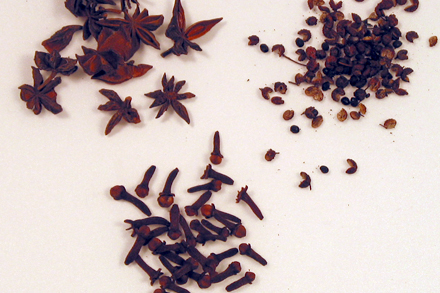
Spices clockwise from top left: star anise, Sichuan pepper and clove
It dawned on me that not everyone is familiar with the basic ingredients of Chinese cooking, much less stocks them in their pantry. So I started putting together a list of the most basic ingredients a Chinese pantry should contain. It was hardly an easy task as there are numerous sauces and spices employed in Chinese cooking. What’s more there are regional differences to take into account as well. But I decided to put together a list for the most common items, plus a few extra spices to include some popular regional cooking styles.
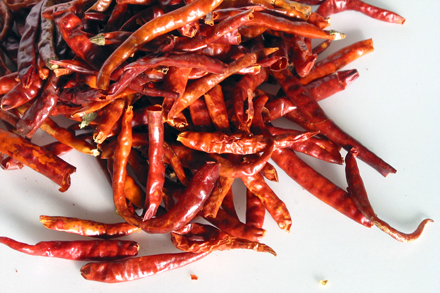
Chinese Red Chili
I spent a long evening moving Post-it stickers, written with ingredients names, back and forth between the “selected” and “unselected” sides of my dining table. So here is the result of my careful, but not quite scientific, analysis.
I decided to divide the ingredients into two groups: oil and sauces, and dried spices. I’m sure some of these ingredients are already in your well-stocked pantry, but I wanted to make sure I gave you a complete list. The other ingredients are not always easily found in regular markets, however all can be purchased from Chinatown markets or Asian mail order outfits.

Oil and sauces from left to right: Shaoxing cooking wine, light soy sauce, oyster sauce, dark soy sauce, sesame oil, vegetable oil and cornstarch
-
Oil and Sauces
- Light soy sauce (生抽) This is the common table soy sauce one finds in any Chinese restaurant. Light soy sauce is the initial product from soy sauce making. It is lighter in color and taste, and has a rather dilute consistency. It should not be confused with Japanese soy sauce. Chinese soy sauce has a nuttier flavor and lighter color.
- Dark soy sauce (老抽) This soy sauce is the product of aging light soy sauce. It is commonly aged for about two to three months. The aging process produces a thicker consistency and darker color sauce. It also results in a slightly sweet taste.
- Shaoxing cooking wine (紹興料酒) Shaoxing wine is a very popular brown rice wine from China. The flavor is reminiscent of dry sherry, which can be used as a substitute. Chinese cooking utilizes this wine just like French cooking uses grape wine: everywhere, all the time.
- Sesame oil (麻油) The classic sesame oil is pressed from toasted sesame seeds and has a nutty fragrance. Although most commonly used in cold dishes, it is often used in hot dim sum dishes or snack food.
- Oyster sauce (蠔油) Originally made by boiling and cooking oysters until a thick pungent sauce is produced, it is now more commonly made from a combination of oysters with other seafood because of the exorbitant price of oysters.
- Vegetable oil (素油) Chinese cooking very often requires high heat over a short period of time. So oil with a higher smoke point is preferable. Soybean, canola, corn or peanut oils are all excellent choices. Olive oil on the other hand is not suitable because of its low smoke point and strong flavor.
- Tapioca starch (木薯粉) Starch is regularly used in Chinese cooking to thicken sauces. The traditional starch used in China is made from tapioca but cornstarch works just as well in the American kitchen.
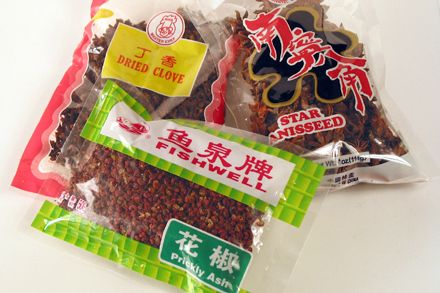
Spices clockwise from top left: clove, star anise and Sichuan pepper
-
Dried Spices
- White pepper (白胡椒粉) Chinese cooking rarely uses black pepper. Finely ground white pepper is preferred.
- Star anise (八角) It is commonly used as one of the stewing or braising spices. It is often found in the spice rack of regular markets.
- Clove (丁香) Just like star anise, whole clove is used in stewing or braising. It is also readily available in regular markets.
- Sichuan pepper (花椒) Also known as flower pepper, it is technically not a pepper. It is the dried fruit of a variety of prickly ash tree widely planted in Asia. It is used extensively in Sichuan cooking, hence the name.
- Dried hot chili (幹辣椒) Chili is widely used in Southwestern Chinese cooking from Sichuan, Hunan and Yunnan provinces. Many varieties are available from Chinatown markets. The most commonly used variety, simply known as red chili by the Chinese, is similar to Arbol chili, which can be found in Mexican food section of regular markets.
Shopping at Chinatown markets can be very daunting. Package labels may not be translated very well, and the staff may not speak English well enough to communicate with you. To make grocery shopping a little more fun and a little less frustrating, you can download the “Kian’s Chinese Cooking Starter Kit” document. It is bilingual so you will know exactly what you’re looking for, and it is in PDF format so the Chinese characters will print properly. Show the list to a store assistant and pray that he or she will be able to find them for you!
Download Kian’s Chinese Cooking Starter Kid



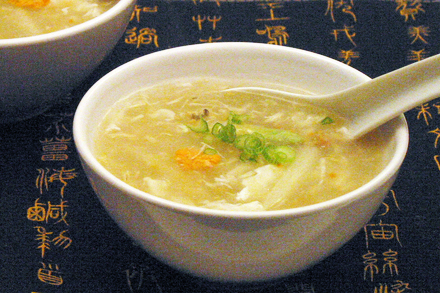


Hi Kian!
I absolutley love your sight and the recipies you’ve made are easy to follow and I can’t wait to have Keith prepare a ” KIAN ” dinner!! I was wondering if you had any Sushi recipies up your sleeve, as you know my little town in Rhode Island basically does not even have a sushi restaraunt. It would sure be nice to be abletodo some simple rolls to start with; if not no worries I am just so glad to have access to some of your fabulous recipies!!! Also let me know if and how to join your sight. As you know I pretty illiterate when it comes to computers! LOL,
Thanks for all the great food ideas, and say hi to Warren for me. Have a great day!,
Louis.
Thank you for the bilingual list of basic ingredients for the starter kit. I have two fabulous Chinese supermarkets close to me and as you suggest not a lot of the folks who work on the floor speak enough English to help me with my shopping list.
Could you also do a list of vegetables, spices, and noodles in a bilingual listing to help me help the staff find the things I need.
And thanks for what I have told friends is the best site with the most accessible recipes for home cooked Chinese food.
Rick
Rick, I’m glad you find the bi-lingual starter kit helpful. Your suggestion for offering bi-lingual lists for other ingredients is great. I will compile some common ingredients in the future.
Hurrah! Thanks so much for putting this together.
Hi..
I am having a hard time finding fermented black beans at the local Asian markets ( Korean and Vietnamese) can you help with the name>
Lee, Fermented black beans in Chinese is 豆豉. You should be able to find them in Chinese or Vietnamiese markets. Good luck.
This is fantastic information! One thing I’d love to know more about is Shaoxing cooking wine. Like all wines, I’m sure there are varying qualities. How do you know which ones are best? Are their particular brands you recommend?
Hi E. D. M., Yes, there are different qualities of Shaoxing wine. The ones labeled as cooking wine generally are the low grade wine bottled by producers of more palatable drinking wine. I think rice wine is more forgiving when low grade version is used in cooking. So I would pick just about any Shaoxing cooking wine from Chinatown. There is one variety of wine I particularly like called “Jia Fan,” and it is made with extra glutinous rice. The flavor is sweeter and works really well in cooking. (Sometimes labeled as “Chia Fan.”)
I have bought light soy sauce but didn’t know how to use at that time. thanks for sharing
Hello.
I have just come across this blog (via Flavor and Fortune magazine) and this 2-year old post which I find quite interesting.
I am a bit surprised by the inclusion of cloves which I don’t relate to Chinese cooking. Can you point to a recipe somewhere? I am also surprised that there is no mention of rice vinegar, garlic, scallions and ginger. Is there some special criteria to exclude these items from a starter kit?
Have a good day.
Hi udscbt,
Thank you for your comment. I would first like to say that the intention of the starter kit is to equip an American kitchen with the initial collection of ingredients for cooking Chinese food. It is not meant to supply the complete pantry of a full fledge Chinese cook. The kit only includes dry ingredients and sauces. Aromatics ingredients such as ginger, garlic and scallions should be stocked as fresh ingredients and not as dried ingredients. Therefore I did not include these items.
As for vinegar I decided not to include either white rice vinegar or black vinegar because they are not an absolute necessity to begin cooking Chinese. Regular white vinegar can often be substituted in many Chinese recipe. Can we add more ingredients to supplement this kit? Absolutely! As one expands on his or her cooking repertoire more ingredients should be added.
Clove is in fact widely used in Chinese cooking. It is often used in braising and stewing. In fact it is one of the main spices in “five spice” powder. Clove is called for in recipes for red cooked beef and red cooked lamb, as well as for marinade in tea smoked duck recipe.
I hope this help explains the idea of a starter kit.
Kian,
I love your blog and how well you demystify Chinese cooking. I have an equipment question for you – my condo building only has electric, no gas. What’s your experience with electric woks? Or should I stick with my cast iron pan?
Hi Theresa,
I lived in a building with electric stove once. I have to admit that it was rather challenging to stir-fry on it. My advise is to go ahead and use a flat bottom carbon steel wok.
Heat the wok on high setting until very hot. Test by holding your hand palm down about an inch above the bottom of the wok. It should feel too hot to keep your hand there. Swirl about two tablespoons of cooking oil and continue to heat for about 30 seconds. The oil should almost reach smoking point. That’s when you want to start stir-frying.
A problem with electric stove is that once you start cooking the temperature immediately drop. One solution is to cook in two smaller batches per recipe.
I hope this will help you.
Kian
very informative,educative.but you have not mentioned anything about MSG because, i’ve seen many cooks using it in chineese cooking.
Sorry for chiming in as I realize that you probably are not addressing your questions at me.
Based on my experience, MSG is a shortcut ingredient that instantly gives you a balanced sweet/salty and “full body flavor.
A lot of oyster sauces have MSG and you can achieve similar results of sweet/salty by simply not shortcutting and simply use brown/white sugar as appropriate, soy sauces, and rich meat flavors.
Most Chinese people believe that a good Chinese chef does not need to use MSG at all to achieve great taste.
You are absolutely right about MSG, riteus. I do not advocate the use of MSG. (In spite of the fact that it was never proven that MSG results in many of the symptoms attributed to it.) It is as you say a short cut to creating flavors.
I always recommend using good rich stocks for enhancing the flavors of food. I have a few recipes for making stocks and I encourage my readers to use them…
http://redcook.net/series/stock-making/
I am also aware that many commercially made sauces such as oyster sauce and bean paste have added MSG in the products. But short of making these sauces yourself I do not have any other substitution recommendation.
I did find a Chinese brand oyster sauce that did not list MSG in the ingredients list. But I am skeptical about the reliability of this claim.
Hi Kian,
I like the list that you’ve put together. I was wondering if you could recommend brands for the soy sauce (or at least identify what’s pictured).
Thanks,
Michael
I used to buy Pearl River Bridge brand soy sauce. I like the slightly caramelized flavor of their products. But I must admit that I am wary of food products from China. You really can’t rely on the quality and product content any more. With so many contamination reports I often hesitate to buy Chinese food products. I now regularly use Amoy brand soy sauces from Hong Kong. For oyster sauce my favorite is still Lee Kum Kee, which is the company that originated the sauce.
Kian,
You are right re: food products from China. They have been “faking” and “shortcutting” lots of foods and sauces these days in order to cut costs and undersell competitors. A lot of these brands should be approached with some skepticism.
That being said, brands from Taiwan and USA tend to be a little bit safer since their products and markets are more mature and have generally stricter health controls. Nevertheless, it’s not like the FDA knows what the heck goes into “Tian Mian Jiang” anyway, so always be go to a grocery store with a keen eye and a few brand recommendations in mind.
I also live in NYC and cook Chinese.I see that we both use the same Shaoxin. I use Pearl River soy sauces, although I’ve recently tried experimenting with Taiwan aged soy sauces to “meh” returns — not seeing any difference at all.
I would also suggest using corn starch over tapioca starch. I’ve been using more tapioca starch recently and have noted its especially “starchy” consistency compared to corn starch. Basically, if you add even a medium amount of tapioca starch, the dish can get “gloopy.” Corn starch seems to be more forgiving with a slightly lower starch content, meaning that it’s harder to overstarch.
Also, forgot to mention:
Being from Singapore, I would assume that your Chinese cooking is heavily biased towards Southern Chinese cuisine. I say this because of your “starter kit” inclusion of oyster sauce. In many traditional kitchens in the Chinese north, oyster sauce is not a common condiment.
In fact, Chinkiang (a specific brand of black rice) vinegar is arguably as important as soy sauce itself in the north where dishes tend to be heavily biased towards salty and garlic-onion and bread/wheat-heavy. Other staples in the northern Chinese pantry include sesame sauce, and fermented tofu ru both red and white.
Thought it was worth clarifying.
Thank you for your thorough and insightful comments. Once again I would like to reiterate that this starter kit is intended as the most basic ingredients list for someone completely new to Chinese cooking. With this kid one can start making simple Chinese food regardless of regional specialties.
I do admit that my experience in cooking is heavily biased towards southern Chinese cooking. But it is possible to create many basic northern dishes with the same kit.
Again what I’m suggesting is never supposed to comprehensively stock a complete Chinese pantry. The list would have been endless if I were to include every possible ingredient for making every cuisine of China.
Hi.
Hope it’s not a problem to comment an entry started many yrs ago.
I agree with riteus that here on this list you put emphasis on southern cooking (oyster sauce) and that there are thing missing (douchi, jiangs, vnegars), but as this kit is aimed at novices, there’s no blame to that. I think that the list serves it’s purpose: it’s clear and summarizing. Really hits the nail on the head.
But…. definitely, you need to correct this sentence:
The traditional starch used in China is made from tapioca
as I am sure that you know that tapioca is made from cassava root (aka manioc). “Tapioca” is a name signifying only the starch itself, while the plant used to make it is called cassava or manioc. I’m guessing it’s just a mere typo, but it’s quite conspicuous while reading.
I always had a problem with starch in Chinese cooking, since I always wanted to find “the main one”. I have read many different Chinese websites and found a myriad of different names and types, so I assume that there is no one-and-only thickener or name for it in China. Regional differences may be crucial here. Most common sources of starch seem to be corn, potato, and cassava, but also sweet potato, mung bean, rice, arrowroot, ku(d)zu, lotus root, water chestnut, taro et al. Some of the latter ones may have been used in ancient times (e.g. before corn and potato starches and tapioca were introduced), as they are indigenous.
I wonder if a specialist like you can clear two things for me:
1. I have encountered “Tang flour” or “Tang starch” in some dumplings recipes. Can You tell me anything about it? Wikipedia says it’s a made of wheat.
2. I heard about Chinese cooks using baking powder to tenderize meat OR to thicken. Can you tell me more about it and do you know how common is this practice and where does it (if at all) happen – cheap bars, deluxe restaurants, at home, everywhere? What kind of powder do YOU use to “velvet”?
I hope it’s not too much to ask such specific questions.
I adore your blog and can’t wait to read your book (gave it a peek and love it!),
best regards,
Kasper
Star Anise (??) is widely used in Chinese cuisines in all regions. This fragrant spice is used in my meat dishes including the famous red cooked pork.